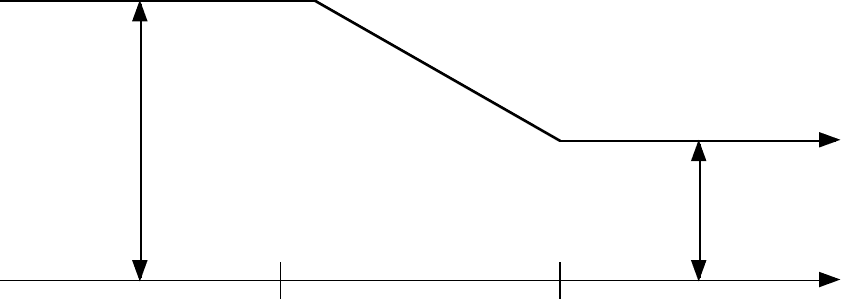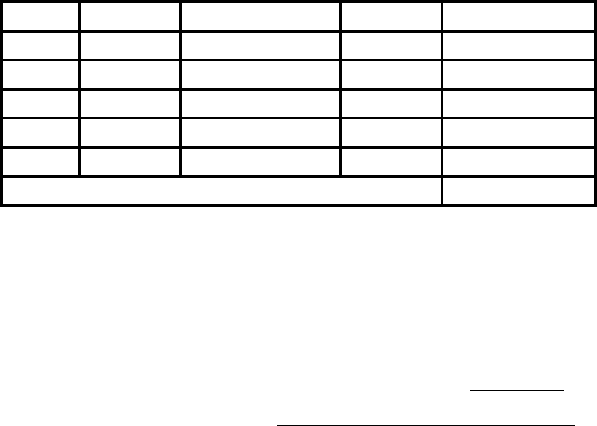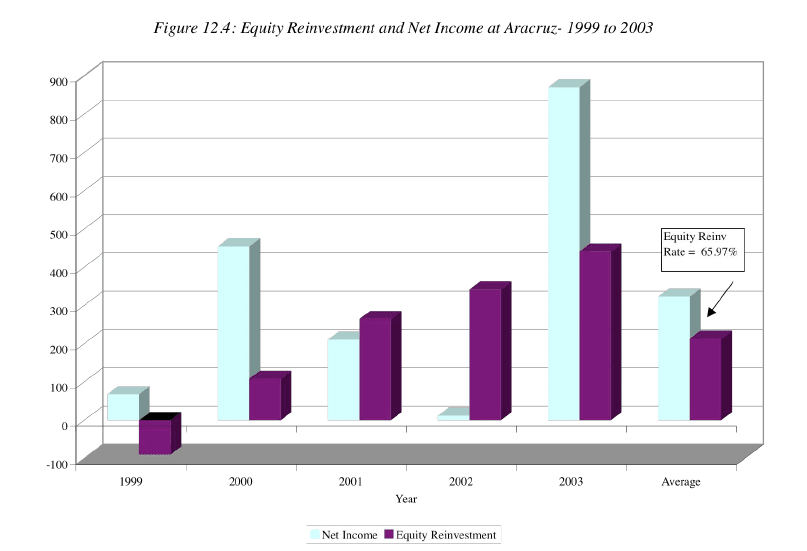Damodaran A. Applied corporate finance
Подождите немного. Документ загружается.


17
17
A more general formulation would allow for growth during the high growth period,
followed by a gradual reduction to stable growth over a transition period, as illustrated in
figure 12.3:
High Growth Period
Stable Growth Period
g
g
n
Figure 12.3: High Growth followed by transition
High Growth
Transition
This model allows for growth rates and payout ratios to change gradually during the transition
period.
Whatever path you devise to get your firm to stable growth, it is not just the growth
rate that should change in stable growth. The other characteristics of the firm should also change
to reflect the stable growth rates.
• The cost of equity should be more reflective of that of a mature firm. If it is being
estimated using a beta, that beta should be closer to one in stable growth even though it
can take on very high or very low values in high growth.
• The dividend payout ratio, which is usually low or zero for high growth firms, should
increase as the firm becomes a stable growth firm. In fact, drawing on the fundamental
growth equation from the last section, we can estimate the payout ratio in stable growth:
Dividend Payout Ratio = 1 – Retention Ratio = 1 – Expected growth rate/ ROE
If we expect the stable growth rate to be 4% and the return on equity in stable growth to
be 12%, the payout ratio in stable growth will be 66.67% (1- 4/12).
• The return on equity in stable growth, if used to estimate the payout ratio, should be also
reflective of a stable growth firm. The most conservative estimate to make in stable

18
18
growth is that the return on equity will be equal to the cost of equity, thus denying the
firm the possibility of excess returns in perpetuity. If this is too rigid a framework, you
can assume that the return on equity will converge on an industry average in the stable
growth phase.
If there is a transition period for growth, as in figure 12.3, the betas and payout ratios should
adjust in the transition period, as the growth rate changes.
12.5. ☞: Terminal Value and Present Value
The bulk of the present value in most discounted cash flow valuations comes from the
terminal value. Therefore, it is reasonable to conclude that the assumptions about growth
during the high growth period do not affect value as much as assumptions about the
terminal value.
a. True
b. False
Explain.
Closing Thoughts on the Dividend Discount Model
Many analysts view the dividend discount model as outmoded but it is a useful
starting point in valuing all companies and may be the only choice in valuing companies
where estimating cashflows is not feasible. As we noted in chapter 11, estimating free
cashflows for financial service companies is often difficult to do both because the line
between operating and capital expenses is a fuzzy one and because working capital,
defined broadly, could include just about all of the balance sheet. While we can arrive at
approximations of cashflows by making assumptions about capital expenditures, we are
often left in the uncomfortable position of assuming that dividends represent free
cashflows to equity for these firms. Even for firms where we can estimate free cash
flows to equity with reasonable precision, the dividend discount model allows us to
estimate a “floor value” in most cases since firms tend to pay out less in dividends than
they have available in free cashflows to equity.
It is often argued that the dividend discount model cannot be used to value high
growth companies that pay little in dividends. That is true only if we use the inflexible
version of the model where future dividends are estimated by growing current dividends.

19
19
In our more flexible version, where both payout ratios and earnings growth can change
over time, the dividend discount model can be extended to cover all types of firms.
There is one final point worth making in this section. We can estimate the value
of equity on a per share basis by using dividends per share or we can obtain the aggregate
value of equity using total dividends paid. The two approaches will yield the same
results, if there are no management options, warrants or convertible bonds outstanding. If
there are equity options, issued by the firm, that are outstanding, it is safest to value the
equity on an aggregate basis. We will consider how best to deal with equity options in
arriving at a value per share later in this chapter.
12.6. ☞: Payout Ratios and Expected Growth
The dividend discount model cannot be used to value stock in a company with high
growth, which does not pay dividends.
a. True
b. False
Explain.
This file on the web contains, by sector, the industry averages for returns on
capital, retention ratios, debt equity ratios and interest rates.
Illustration 12.3: Valuing equity using the Dividend Discount Model: Deutsche Bank
In illustration 12.2, we estimated the annual growth rate for the next 5 years at
Deutsche Bank to be 7.36%, based upon an estimated ROE of 11.26% and a retention
ratio of 65.36%. In 2003, the earnings per share at Deutsche Bank were 4.33 Euros, and
the dividend per share was 1.50 Euros. Our earlier analysis of the risk at Deutsche Bank
provided us with an estimate of beta of 0.98, which used in conjunction with the Euro
riskfree rate of 4.05% and a risk premium of 4.82%, yielded a cost of equity of 8.76%
(see illustration 4.11).

20
20
Based upon these inputs, we estimate the expected earnings per share and
dividends per share for the next 5 years, and the present value of these dividends in table
12.2:
Table 12.2: Present Value of Expected Dividends for High Growth Period
Year
EPS
Payout Ratio
DPS
PV at 8.76 %
1
€4.65
34.64 %
€1.61
€1.48
2
€4.99
34.64 %
€1.73
€1.46
3
€5.36
34.64 %
€1.86
€1.44
4
€5.75
34.64 %
€1.99
€1.42
5
€6.18
34.64 %
€2.14
€1.41
Present value of expected dividends =
€7.22
Note that we could have arrived at the same present value, using the short cut described
earlier (since the payout ratio and the cost of equity remain unchanged for the high
growth period):
!
PV of High - growth dividends
0
=
1.50 * (1.0736) * 1-
(1.0736)
5
(1.0876)
5
"
#
$
%
&
'
.0876 - .0736
= 7.22
At the end of year 5, we will assume that Deutsche Bank’s earnings growth will drop to
4% and stay at that level in perpetuity. In keeping with the assumption of stable growth,
we will also assume that
• The beta will rise marginally to 1, resulting in a slightly higher cost of equity of
8.87%.
Cost of Equity = Riskfree Rate + Beta * Risk Premium = 4.05%+ 4.82% = 8.87%
• The return on equity will drop to the cost of equity of 8.87%, thus preventing
excess returns from being earned in perpetuity.
• The payout ratio will adjust to reflect the stable period growth rate and return on
equity.
Stable Period Payout Ratio = 1 – g/ ROE = 1- .04/.0887 = .5490 or 54.9%
The expected dividends in year 6 is calculated using this payout ratio:
Expected Dividends in year 6 = Expected EPS
6
* Stable period payout ratio
=€6.18 (1.04) * .549 = €3.5263
The value per share at the end of the fifth year can be estimated using these inputs:
Terminal Value per share = Expected Dividends in year 6/ (Cost of equity – g)

21
21
= €3.5263/(.0887 - .04) = €72.41
The present value of the terminal value is computed using the high growth period cost of
equity:
Present value of terminal value = Terminal Value/ (1+r)
n
= 72.41/1.0876
5
= 47.59
The total value per share is the sum of this value and the present value of the expected
dividends in the high growth period:
Value per share = PV of expected dividends in high growth + PV of terminal value
= €7.22 + €47.59 = €54.80
The market price of Deutsche Bank at the time of this valuation was 66 Euros per share.
Based upon out assumptions, Deutsche Bank looks over valued.
II. Free Cashflow to Equity Models
In Chapter 11, while developing a framework for analyzing dividend policy we
estimated the free cash flow to equity as the cash flow that the firm can afford to pay out
as dividends, and contrasted it with the actual dividends. We noted that many firms do
not pay out their FCFE as dividends; thus, the dividend discount model may not capture
their true capacity to generate cash flows for stockholders. A more appropriate model is
the free cash flow to equity model.
Setting up the Model
The FCFE is the residual cash flow left over after meeting interest and principal
payments and providing for capital expenditures to maintain existing assets and to create
new assets for future growth. The free cash flow to equity is measured as follows:
FCFE = Net Income + Depreciation - Capital Expenditures - Δ Working Capital -
Principal Repayments + New Debt Issues
where Δ Working Capital is the change in non-cash working capital.
In the special case where the capital expenditures and the working capital are
expected to be financed at the target debt ratio δ, and principal repayments are made from
new debt issues, the FCFE is measured as follows:
FCFE = Net Income + (1-δ) (Capital Expenditures - Depreciation) + (1-δ) Δ Working
Capital

22
22
There is one more way in which we can present the free cash flow to equity. If we define
the portion of the net income that equity investors reinvest back into the firm as the
equity reinvestment rate, we can state the FCFE as a function of this rate.
Equity Reinvestment Rate
=
!
(Capital Expenditures - Depreciation + " Working Capital) (1-
#
)
Net Income
FCFE = Net Income (1 – Equity Reinvestment Rate)
Once we estimate the FCFE, the general version of the FCFE model resembles the
dividend discount model, with FCFE replacing dividends in the equation:
Value of the Stock = PV of FCFE during high growth + PV of terminal price
!
Value
0
=
E(FCFE)
t
(1 +r)
t
t =1
t =n
"
+
Terminal Value
n
(1 +r)
n
where Terminal Value
n
=
E(FCFE)
n +1
(r
n
- g
n
)
where the expected free cashflows to equity are estimated each year for the high growth
period, r is the cost of equity and g
n
is the stable growth rate.
There is one key difference between the two models, though. While the dividends
can never be less than zero, the free cashflows to equity can be negative. This can occur
even if earnings are positive, if the firm has substantial working capital and capital
expenditure needs. In fact, the expected free cashflows to equity for many small, high
growth firms will be negative at least in the early years, when reinvestment needs are
high, but will become positive as the growth rates and reinvestment needs decrease.
In Practice: Estimating Capital Expenditure and Working Capital Needs
Two components go into estimating reinvestments. The first is net capital
expenditures, which is the difference between capital expenditures and depreciation.
While these numbers can easily be obtained for the current year for any firm in the
United States
8
, they should be used with the following caveats:
1. Firms seldom have smooth capital expenditure streams. Firms can go through periods
when capital expenditures are very high, followed by periods of relatively light
capital expenditures. Consequently, when estimating the capital expenditures to use

23
23
for forecasting future cash flows, we should look at capital expenditures over time
and normalize them by taking an average or we should look at industry norms.
2. If we define capital expenditures are expenditures designed to generate benefits over
many years, research and development expenses are really capital expenditures.
Consequently, R&D expenses need to be treated as capital expenditures, and the
research asset that is created as a consequence needs to be amortized, with the
amortization showing up as part of depreciation.
9
3. Finally, in estimating capital expenditures, we should not distinguish between internal
investments (which are usually categorized as capital expenditures in cash flow
statements) and external investments (which are acquisitions). The capital
expenditures of a firm, therefore, need to include acquisitions. Since firms seldom
make acquisitions every year, and each acquisition has a different price tag, the point
about normalizing capital expenditures applies even more strongly to this item.
The second component of reinvestment is the cash that needs to be set aside for working
capital needs. As in the chapters on investment analysis, we define working capital needs
as non-cash working capital, and the cash flow effect is the period-to-period change in
this number. Again, while we can estimate this change for any year using financial
statements, it has to be used with caution. Changes in non-cash working capital are
volatile, with big increases in some years followed by big decreases in the following
years. To ensure that the projections are not the result of an unusual base year, we tie the
changes in working capital to expected changes in revenues or costs of goods sold at the
firm over time. For instance, we use the non-cash working capital as a percent of
revenues, in conjunction with expected revenue changes each period, to estimate
projected changes in non-cash working capital. As a final point, non-cash working capital
can be negative, which can translate into positive cash flows from working capital as
8
It is actually surprisingly difficult to obtain the capital expenditure numbers even for large, publicly
traded firms in some markets outside the United States. Accounting standards, in these markets, often allow
firms to lump investments together and report them in the aggregate.
9
Capitalizing R&D is a three-step process. First, you need to specify, on average, how long it takes for
research to pay off (amortizable life). Second, you have to collect R&D expenses from the past for an
equivalent period. Third, the past R&D expenses have to be written off (straight line) over the amortizable
life.

24
24
revenue increases. It is prudent, when this occurs, to set non-cash working capital needs
to zero
10
.
Estimating Model Inputs
Just as in the dividend discount model, there are four basic inputs needed for this
model to be usable. First, the length of the high growth period is defined. Second, the free
cash flow to equity each period during the growth period is specified; this means that net
capital expenditures, working capital needs and the debt financing mix are all estimated
for the high growth period. Third, the rate of return stockholders will demand for holding
the stock is estimated. Finally, the terminal value of equity at the end of the high growth
period is calculated, based upon the estimates of stable growth, the free cash flows to
equity and required return after the high growth ends. Of the four inputs, the length of the
high growth period and the rate of return required by stockholders are the same for the
dividend discount and FCFE valuation models. On the other two, the differences in the
other two inputs are minor but still worth emphasizing.
a. Estimating FCFE during High Growth Period
As in the dividend discount model, we start with the earnings per share and estimate
expected growth in earnings. Thus, the entire discussion about earnings growth in the
dividend discount model applies here as well. The only difference is in the estimation of
fundamental growth. When estimating fundamental growth in the dividend discount
model, we used the retention ratio and the return on equity to estimate the expected
growth in earnings. When estimating fundamental growth in the FCFE valuation model,
it is more consistent to use the equity reinvestment rate that we defined in the last section
and the return on equity to estimate expected growth:
Expected Growth in Net Income = Equity Reinvestment Rate * Return on Equity
Unlike the retention ratio, which cannot exceed 100% or be less than 0%, the equity
reinvestment rate can be negative (if capital expenditures drop below depreciation) or
greater than 100%. If the equity reinvestment rate is negative and is expected to remain
so for the foreseeable future, the expected growth in earnings will be negative. If the
10
While it is entirely possible that firms can generate positive cash flows from working capital decreasing

25
25
equity reinvestment rate is greater than 100%, the net income can grow at a rate higher
than the return on equity though the firm will have to issue new stock to fund the
reinvestment.
11
Once the earnings are estimated, the net capital expenditures, working capital needs,
and debt financing needs have to be specified in order to arrive at the FCFE. Just as the
dividend payout ratio was adjusted to reflect changes in expected growth, the net capital
expenditure and working capital needs should change as the growth rate changes. In
particular, high growth companies will have relatively higher net capital expenditures and
working capital needs. In other words, the equity reinvestment rate will generally be high
in high growth and decline as the growth rate declines. A similar point can be made about
leverage. High growth, high risk firms generally do not use much leverage to finance
investment needs; as the growth tapers off, however, the firm will be much more willing
to use debt, suggesting that debt ratios will increase as growth rates drop.
There is one final point worth making about equity valuations. Since the net income
includes both income from operations and income from cash and marketable securities,
we have two choices when it comes to equity valuations. The first and easier, albeit less
precise one, is to discount the total free cashflow to equity (including the income from
cash holdings) at a cost of equity that is adjusted to reflect the cash holdings.
12
The
present value of equity will then incorporate the cash holdings of the company. The
second and more precise way is to discount the net income, without including the interest
income from cash, at a cost of equity that reflects only the operations of the firm and then
to add the cash and marketable securities on to this present value at the end.
This file on the web contains, by sector, the industry averages for net capital
expenditures and working capital as a percent of revenues.
for short periods, it is dangerous to assume that this can occur forever.
11
If the equity reinvestment rate exceeds 100%, the net income of the firm is insuffuicient to cover the
equity reinvestment needs of the firm. Fresh equity will have to be issued to fund the difference. This will
increase the number of shares outstanding.
12
The beta for equity will be based upon an unlevered beta, adjusted for the cash holdings of the company.
In other words, if the company is 20% cash and 80% operations, the unlevered beta will be estimated
attaching a 20% weight to cash and a beta of zero for cash.

26
26
Illustration 12.4: Estimating Growth Rate in Net Income
Like many manufacturing firms, Aracruz has volatile reinvestment outlays and
the cashflows from debt swing wildly from year to year. In figure 12.4, we report on net
income and equity reinvestment (capital expenditures – depreciation + change in non-
cash working capital – net cashflow from debt) each year from 1999 to 2003:
Rather than base the equity reinvestment rate on the most recent year’s numbers, we will
use the average values for each of the variables over the entire period to compute a
“normalized” equity reinvestment rate:
Normalized Equity Reinvestment Rate = Average Equity Reinvestment
99-03
/
Average Net Income
99-03
= 213.17/323.12 = 65.97%
To estimate the return on equity, we look at only the portion of the net income that comes
from operations (ignoring the income from cash and marketable securities) and divide by
the book value of equity net of cash and marketable securities. This non-cash ROE is a
cleaner measure of the returns on equity in operating assets.
Non-cash ROE = (Net Income – After-tax Interest income on cash)
2003
/ (BV of Equity –
Cash)
2002
